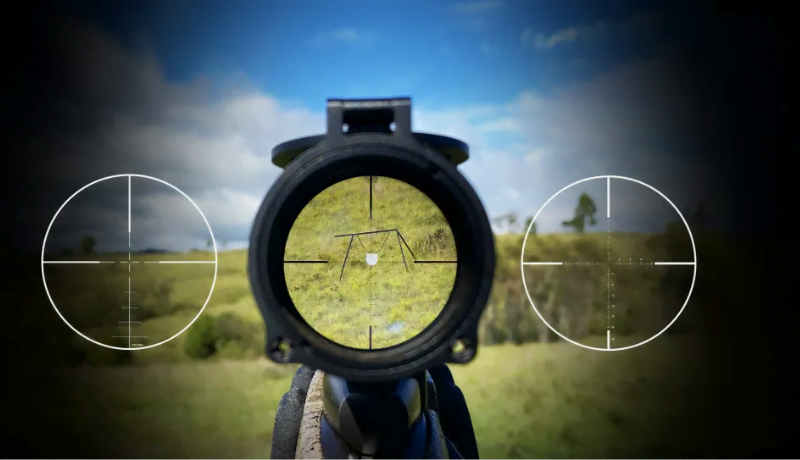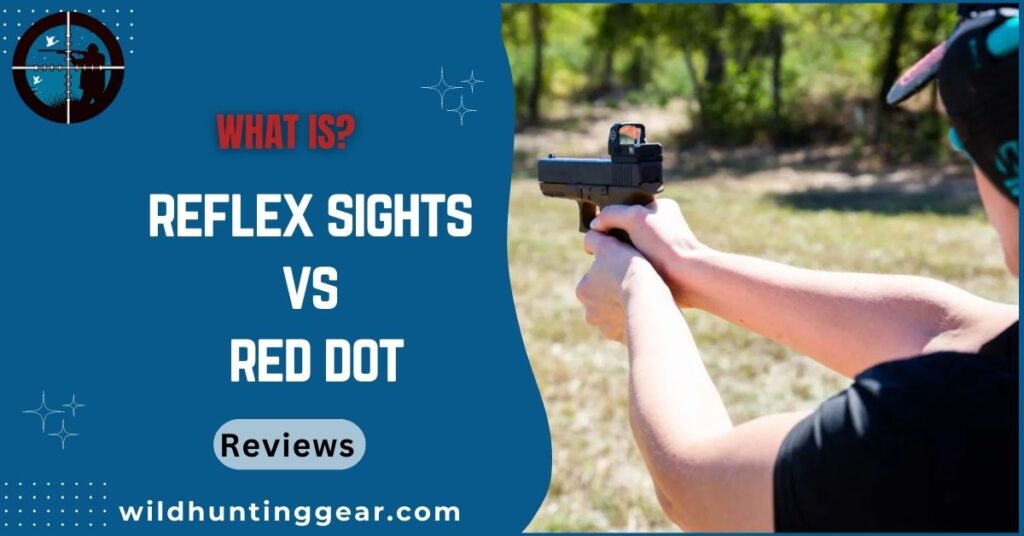it comes to enhancing accuracy and precision in shooting sports the use of optical sighting devices has become increasingly popular. Among the various options available, reflex sights and red dot sights have gained considerable attention. But what’s difference between the two?
In this article, we will delve into the key differences between reflex sights and red dot sights, shedding light on their designs, functionalities and applications.

Whether you’re a beginner exploring the world of firearms or an experienced shooter seeking to upgrade your gear, this comparison will help you make an informed decision regarding the optimal sight for your shooting endeavors. Stay tuned!
Understanding of Reflex Sights

1) Definition and basic functionality:
Reflex sights are optical devices that are designed to help shooters acquire their target accurately and quickly. Their design consists of an illuminated reticle that is projected by a red LED emitter onto a lens, which projects the image into the shooter’s eye.
They are particularly useful for close-range shooting situations since they provide users with an unobstructed field of view, allowing for excellent target acquisition and tracking. Reflex sights are usually powered by batteries, which provide the necessary illumination for the reticle.
2) Optical design and reticle projection:
Reflex sights employ a simple optical design consisting of a collimated light source, a lens system and a partially reflective mirror or prism.
The collimated light source emits a focused beam of light, which is then reflected off the partially reflective surface toward the shooter’s eye. The lens system helps collimate the light, ensuring parallel rays reach the shooter’s eye, creating a virtual image of the reticle.
Reticle projection is achieved through the use of either an LED (Light Emitting Diode) or a laser diode. LED-based reflex sights utilize an LED positioned behind the reticle, emitting light directly onto the partially reflective surface. The reticle is then reflected to the shooter’s eye, appearing as if it is hovering over the target.
In laser-based reflex sights, a laser diode is employed to project the reticle onto the display. The laser beam is directed onto a mirror or prism, which reflects it onto the partially reflective surface, allowing the shooter to see the reticle in the field of view.
3) Types of reflex sights:
Reflex sights come in various designs, with two primary types being tube-style and open-style sights.
- Tube-style reflex sights: Tube-style reflex sights feature a cylindrical housing that encloses the optical components. They typically offer better protection against impact, dust and water, making them suitable for rugged environments. Tube-style sights often have a tubular field of view, limiting the obstruction of peripheral vision.
- Open-style reflex sights: Open-style reflex sights, as the name suggests, have an open construction, with the optical components exposed.

They offer a wide and unobstructed field of view, providing shooters with enhanced situational awareness. Open-style sights are often compact and lightweight, making them suitable for applications where size and weight are crucial factors.
These types of reflex sights may have additional features like adjustable brightness settings, night vision compatibility, motion sensors and battery-saving technologies, further enhancing their versatility and performance in various shooting scenarios.
Understanding of Red Dot Sights

1) Definition and functioning of red dot sights:
Red dot sights are optical devices used for aiming and targeting various shooting activities. They are popular among firearms enthusiasts, hunters and competitive shooters. The main purpose of a red dot sight is to provide a clear and precise aiming point on the target, improving accuracy and target acquisition.
Red dot sights work by projecting a small, illuminated dot onto a specially coated lens. This dot appears to be floating in front of the user’s eyes, aligning with the target. The user looks through the sight and sees the dot superimposed on the target, allowing for quick and easy aiming. The dot is usually red in color but some sights offer different colors like green or blue.

2) Illuminated reticle technology:
The illuminated reticle technology used in red dot sights ensures that the dot remains visible in various lighting conditions. It relies on LED (light-emitting diode) technology, which produces a bright and focused light source.
The LED inside the sight emits light onto a specially designed lens, which reflects the light back to the user’s eye. This creates the illusion of a floating dot in the line of sight.
The brightness of the dot can be adjusted to match the ambient lighting conditions. This feature is particularly useful when transitioning between bright outdoor environments and darker indoor settings. By adjusting the brightness level, users can ensure optimal visibility of the dot without it appearing too dim or overwhelming.
3) Types of red dot sights
There are two main types of red dot sights:
- Tube-style red dot sights: These sights have a cylindrical or tubular shape. They consist of a main tube that houses the optical components and the LED light source. Tube-style sights often offer a more enclosed and protected design, shielding the lens and internal components from potential damage due to impacts or environmental elements.
- Open-style red dot sights: Open-style sights have a more compact and exposed design. They do not have a cylindrical tube enclosing the optics and LED.
Instead, they feature a window-like opening through which the user looks to see the dot. Open-style sights are often lightweight and provide a wider field of view, allowing for faster target acquisition.
Remember, red dot sights are valuable tools that can enhance your shooting experience, providing a precise aiming solution that can greatly improve accuracy and target acquisition.
Related Article: Can You Use A Golf Rangefinder For Hunting?
Key differences between reflex sights and red dot sights
Here are the key differences between reflex sights and red dot sights in the table so that you better understand them.
| Feature | Reflex Sight | Red Dot Sight |
| Optical Design | Consists of a collimated light source, a lens system and a partially reflective mirror/prism. | Projected onto the display using an LED or laser diode. |
| Reticle Projection | Uses either LED or Laser Diode to project the reticle onto the display. | Dot is illuminated onto a lens. |
| Sight Picture | Appears as if the reticle is hovering over the target. | Dot appears to be floating in front of the user’s eye, aligning with the target. |
| Parallax | No parallax is present due to the reticle projection technology. | Parallax can be present depending on the design and construction of sight. |
| Battery Life | Dependent on the reticle projection technology used (LED or Laser Diode) and additional features. | LED technology provides long battery life and adjustable brightness settings help to conserve power. |
| Field of View | Tube-style sights offer a tubular field of view; open-style sights provide an unobstructed field of view. | Open-style sights offer a wide field of view; tube-style sights may obstruct peripheral vision. |
| Weight | Generally heavier than red dot sights due to sealed construction. | Lightweight open design helps to reduce overall weight and bulkiness. |
| Price Range | More expensive than red dot sights due to additional features and enclosed construction. | Red dot sights are often more affordable than reflex sights. |
| Durability | Sealed construction offers enhanced durability in harsher environments. | Open design is not as durable as tube-style sights. |
| Usage | Generally used for long-range and precision shooting scenarios due to reticle options and accuracy. | Ideal for short-to-medium-range shooting activities and plinking/target practice. |
The differences between reflex sights and red dot sights are quite significant, so it’s important to be aware of these factors before choosing the type of sight that best suits your needs and shooting activities.
Pros and cons of reflex sights
Pros
- Offers improved accuracy and precision due to its reticle projection technology and variable reticle options
- Enclosed construction provides enhanced durability in harsher environments
- Sealed design shields the optics from potential damage due to impacts or environmental elements
- Provides an unobstructed field of view for quick and easy target acquisition
- Longer battery life due to LED or Laser Diode reticle projection technology
- Suitable for long-range and precision shooting scenarios due to accuracy
Cons
- Generally heavier than red dot sights due to enclosed construction
- More expensive than red dot sights, depending on the features and manufacturer
- May obstruct peripheral vision due to tube-style construction
- Variable reticles may not be available on all models, depending on the sight and manufacturer
- Not suited for short-to-medium range shooting activities due to lack of suitable aiming solutions
Pros and cons of red dot sights
Pros
- Offers quick and easy target acquisition due to its wide field of view
- Lightweight open design helps to reduce overall weight and bulkiness
- Generally more affordable than reflex sights, depending on the features and manufacturer
- The projected dot is illuminated onto a lens for easier visibility in different lighting conditions
- LED technology provides long battery life and adjustable brightness settings help to conserve power
- Ideal for short-to-medium range shooting activities and plinking/target practice
Cons
- Offers quick and easy target acquisition due to its wide field of view
- Lightweight open design helps to reduce overall weight and bulkiness
- Generally more affordable than reflex sights, depending on the features and manufacturer
- The projected dot is illuminated onto a lens for easier visibility in different lighting conditions
- LED technology provides long battery life and adjustable brightness settings help to conserve power
- Ideal for short-to-medium range shooting activities and plinking/target practice
When deciding between a reflex sight and red dot sight for your shooting activities, it’s important to consider the pros and cons of each type of sight in relation to your specific needs and budget.
Considerations for Choosing between reflex sights and red dot sights
When choosing between a reflex sight and a red dot sight, there are several important considerations to keep in mind. These include:
1) Intended Use: Consider what type of shooting activities you’ll be engaging in long-range or short/medium-range – and choose the sight that best suits your needs. For example, if you’re primarily shooting at longer distances, a reflex sight may be the better choice for its superior accuracy.
On the other hand, if you mostly shoot at shorter ranges or engage in target practice and plinking activities, then a red dot sight might be more suitable with its quick target acquisition and affordable price tag.
2) Budget: It’s important to factor in your budget when looking at reflex and red dot sights. Generally speaking, reflex sights tend to be more expensive than red dot sights due to their additional features and enclosed construction.
3) Weight: Consider the overall weight of the sight; if you’ll be shooting in multiple locations or plan on traveling with your firearm, it’s important to choose a lightweight sight that won’t add too much bulk and weight to your setup.
In this regard, open-style red dot sights are often the better choice as they provide a wide field of view but don’t weigh as much as tube-style reflex sights.
4) Reticle Options: Consider the type of reticle options available with each sight type. Reflex sights generally offer variable reticles that are adjustable for different shooting scenarios, while red dot sights usually only have a single dot-style reticle.
5) Firearm platform and mounting options: Be sure to consider the type of firearm platform you’ll be using and ensure that the sight you choose is compatible with your platform. Additionally, make sure that the mounting system used by the sight is suitable for your specific setup.
6) Personal preferences and shooting style: Finally, it’s important to factor in your own personal preferences and shooting style when deciding which type of sight is best for you. Everyone has different tastes and needs, so be sure to pick the one that feels most comfortable and intuitive to you.
7) Budget and cost factors: Lastly, do not forget to factor in your budget and cost factors when choosing between the two sights. Reflex sights are generally more expensive than red dot sights due to their additional features and enclosed construction; however, if money is not an issue, then this should not be a major concern.
Ultimately, you should choose the sight that best suits your needs while also considering your budget.
By considering all these points, you’ll be able to make an informed decision and choose the sight that best meets your needs. Doing your research on different sight models, reading reviews and talking with experienced shooters can help you make an educated decision that will serve you well on the range.
Conclusion:
In conclusion, while reflex sights and red dot sights have similar functionalities and offer quick target acquisition, the key difference lies in their reticle designs.
Reflex sights use a curved lens to project a reticle onto the target, providing a more precise aiming point, while red dot sights use an LED to create a simple red dot as the reticle. Ultimately, the choice between the two depends on personal preference and specific shooting needs.




